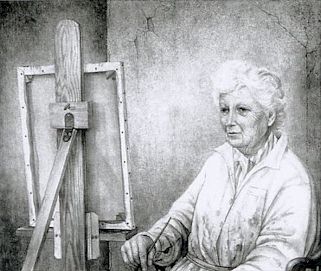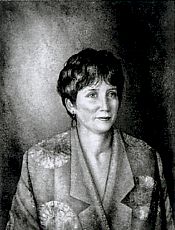|
Into something rich When I was given two boxes of watercolour by my family at Christmas. I felt disappointed because I had never explored this medium very much. Watercolour always seemed insipid to me. I thought of all those washed-out landscapes I’d done in the past, and my heart sank. Then I asked myself, what if you’d never seer, any watercolour paintings before and you lust use the point as colours as a child might do — what would happen? This was an exciting thought and I flung myself into the joy of experimenting. One thing I had noticed about watercolour was that it was difficult to build up layers of washes; the picture very soon lost its freshness. But what if I used a toothbrush to spatter, and built up layers of washes that way? It was thrilling to find that this worked, and I could build up a series of layers in different colours without losing the fresh look, partly because the white paper still showed through between the spatters. There is a dynamic quality about accidental spattering that is extraordinarily exciting. I tried various implements besides the toothbrush. For example nail brushes and clothes brushes, and for very small areas I spattered with a small bristle paint brush. The spattering looked best as a background to more careful painting. So I first drew the subject — either a flower arrangement or a portrait — and then cut out a shape of clear plastic to fit over it exactly (plastic file cases are good for this). Then I weighted the plastic down with coins, arid splattered. I found this much better than masking fluid, because often this can be hard to remove, and it is expensive for wide areas. I discovered after a time that the best method is to draw the subject, spatter the background, then complete the subject and spatter again at the end to give the finishing touch — perhaps just a little accent here and there — but it makes all the difference. So it is important not to throw away the plastic cutout until the painting is completely finished.
She is 90 and still painting. and wanted to give the effect of antiquity and yet freshness, which is suggested by the intentness of her glance. Gold leaf In the portrait of Eve (below) in a gold embroidered jacket (above left), I wanted to go to the other extreme and create an effect of richness. I spattered and re-spattered until the background resembled an oil painting, and then I discovered a new gold leaf, which can be applied to watercolour paper. It is bronze which has been treated in such a way that it comes in glowing coloured patterns. rather like the patina on an old copper kettle.
|
 In the portrait of my
mother (left) I used the spattering to give the effect of a very old
studio, and added cracks in the wall to enhance the effect.
In the portrait of my
mother (left) I used the spattering to give the effect of a very old
studio, and added cracks in the wall to enhance the effect. This is available from
Cornelissen's, 105 Great Russell Street, London (Tel: 0171 636 1045).
You can get five 6in. square sheets for £6.40, and it is not difficult
to apply. Cornelissen also sell water-based gold size to glue down the
sheets. But do read the instructions if you apply the gold too early it
won’t stick — too late and ditto! Afterwards you must app4y a
varnish to cover the gold or it will tarnish. The varnish can be
purchased at the same time as the gold sheets and is not difficult to
apply.
This is available from
Cornelissen's, 105 Great Russell Street, London (Tel: 0171 636 1045).
You can get five 6in. square sheets for £6.40, and it is not difficult
to apply. Cornelissen also sell water-based gold size to glue down the
sheets. But do read the instructions if you apply the gold too early it
won’t stick — too late and ditto! Afterwards you must app4y a
varnish to cover the gold or it will tarnish. The varnish can be
purchased at the same time as the gold sheets and is not difficult to
apply.